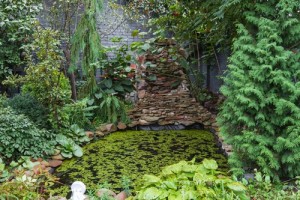Posts Tagged landscape
Plant Trees and Shrubs That Add Interest to a Garden in Winter
Tons of homeowners run down to their local nursery to pick up shrubs and small trees for their garden design. You can actually find some great deals by purchasing cold-hardy plants, shrubs and trees out of season, so to speak, prior to the thermometer dropping in September and October.
The problem is that these same homeowners don’t exactly know what to do with their cold-hardy plants and shrubs or whether they can set to work planting them in late fall and early winter or if they have to wait until the weather warms up in spring to put on their gardener’s hat.
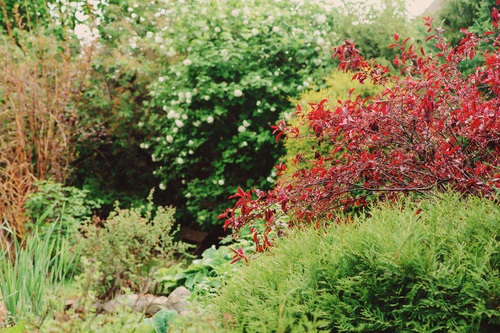
How to Deal with Cold-Hardy Trees, Plants and Shrubs
What you may not know is that a variety of shrubs, plants, perennials, and trees can survive and even thrive in – what the USDA terms – the coldest planting zones in the country.
So, the question no doubt on the minds of everyone in these more frigid hardiness zones is whether to keep your trees and shrubs in pots throughout the cooler months or whether you can get started in late fall.
The answer’s that you can choose to do either, but you can definitely set to work right now, start planting in the late fall, and beautify your garden and outdoor decor throughout the winter and into the verdant spring months. Evergreen shrubs and hawthorn are two popular options.
What you still want to do, though, is manage your expectations and perhaps set your sights lower than a veritable Garden of Eden springing up in the crisp winter months. Here’s how to get started:
- Follow Nature’s Lead
You would be very hard-pressed to find potted plants, much less artificial ones, growing wild out in nature.
Taken that to its logical extension, your plants and shrubs will typically be healthier and happier by being put into the ground than staying in a plastic pot in your garage throughout the winter season.
- What Should I Plant?
Evergreen garden shrubs are but one example of resilient shrubs that can really add another dimension to your garden and front lawn during the winter without causing too much heartache in terms of worry or added energy you have to expend to make it happen.
Both conifer trees and evergreen shrubs can make it through winter in one piece, and the needle-leaf style of evergreen shrubs are normally considered more robust in cold-hardy climates.
Yew and Juniper are two kinds of evergreen garden shrubs that are resilient, tolerant to cold temperatures and drought conditions, yet really benefit from developing their root networks early in the fall (if you’re thinking about planting these early) as opposed to waiting until early-to-mid spring.
Deciduous trees like the Japanese Maple, eucalyptus, birch or hawthorn tree can even demonstrate fruit growth in the winter, which really adds a splash of color and interesting contrast against the icicles and powdery, white winter snow.
- Going About It the Right Way
Year-round plants, shrubs and trees don’t actually need the extra shot in the arm that less hardy flora might.
There’s no need to use a crazy amount of fertilizer or growth agents in the late fall to get the most out of these trees and shrubs throughout the winter.
Still, realize that many of these flora grow upwards and their root networks are delicate at this early stage. Try not to move around or prune these shrubs early in their development.
Much and a little water in the fall are probably all these plants need to avoid desiccation and thrive for you year-round. Contact us today for more tips or help in getting started.
Xeriscape California Plant List
California boasts a rich variety of flowers, trees, and flora ~ a somewhat surprising fact considering the prevalence of arid landscapes and drought. Home and business owners who want an eco-friendly, economic landscaping solution would be wise to utilize xeriscape, a form of landscaping that combines drought-resistant plants, efficient irrigation, and thoughtful garden design to create beautiful outdoor spaces. To get started, check out this list of plants that will make a wonderful addition to your xeriscaping.

Aloe
Aloes are a variety of succulents that do well in dry environments. One common variety is Aloe Vera, also known as burn plant due to its ability to soothe sunburn. Aloe Vera can grow up to 3 feet in height and produces lovely yellow flowers. Although commonly grown as houseplants, Aloes can also thrive in xeriscape environments due to their preference for bright light and dry, well-draining soil.
Agave
This xeriscape-friendly plant is known for its use in making tequila! There are many different varieties, but all have a main taproot that discourages transplanting after they have been installed. A loose, well-draining soil is a must and plants prefer to dry out completely between watering. Agave tends to bloom once, then die, but often produces pups, or baby plants, that can replace the original.
Mexican Sage
A member of the Salvia family, Mexican Sage is a perennial that produces gorgeous purple or white flowers that can make it a stunning xeriscape addition. Moisture requirements are somewhat higher than for previously mentioned succulent varieties, so it may not be ideal for very arid locations. However, it is drought tolerant and often attracts pollinators like butterflies and hummingbirds.
Verbena
Verbena comes in many varieties, including lemon, rose, and purpletop, just to name a few. Lemon verbena smells fantastic and can be used to make herbal tea. They can be grown as annuals or perennials and are resistant to heat and drought. Depending on the variety you choose, they can get quite tall and bushy, often producing beautiful, brightly colored flowers.
Honeysuckle
Most honeysuckle vine varieties smell fantastic, attract pollinators, produce beautiful flowers, and come back year-after-year. Being heat and drought resistant and fairly low maintenance makes them a wonderful addition to xeriscape areas. Full to partial sun and a well-draining soil are preferable. A fence, trellis, or other support system helps them grow to their full potential.
Sedge Grass
Sedges are a large family of grasses that work well in place of more high maintenance turf grass. They tend to be adaptable and often require little water. California meadow sedge is native to the Pacific coast area and tolerates heat, drought, and even foot traffic. It can be used as part of an eye-catching xeriscape focal point or used to replace a more traditional lawn. Since it requires very little mowing and no fertilizers or other chemicals, sedge grass is a great, no-fuss addition to any landscape.
Hollyleaf Cherry
The hollyleaf cherry tree is a shrub native to the California coast that produces lush, evergreen leaves, cream colored flowers, and edible fruit. The fruit is not very fleshy though, so it probably won’t become your favorite snack, but birds and other wildlife may appreciate it. Hollyleaf cherry is very tolerant of drought, thrives in full to partial sun, and prefers well-draining soil.
Xeriscape landscaping techniques are sure to become more popular as awareness grows about the need to conserve water and choose drought resistant plants. DK Landscaping strives to create beautiful landscapes that function well in the natural environment, so call us or contact us via email today to get started on a xeriscape project for your home or business.
Plant Maintenance : Sprinkler Systems, Irrigation Controllers
A home plant maintenance system might just be the most worthwhile outdoor home improvement project going today. An automated sprinkler system – brought under your control with an irrigation controller – beautifies your entire lawn and garden and makes having guests over a pleasure instead of something to fret over.
Irrigation systems are designed to efficiently deliver water straight to your roots without squandering water and overwatering, which can cause its own set of problems. You really want to avoid overwatering since waterlogged soil precludes your roots from absorbing oxygen and really flourishing.

How Homeowners Benefit By Automating Their Irrigation
Without a home automated sprinkler system or drip irrigation system loaded with sensors and brought under your control with an irrigation controller, it can be difficult to determine what exactly the right amount of water for your lawn and garden.
An automated system with controllers and sensors, in short, allows you to have greater peace of mind and save potentially hundreds of hours every year on watering and manual maintenance that could otherwise be automated and strictly measured with Smart controllers and sensors.
- Irrigation Controllers For Your Home
Automated sprinkler systems outfitted with an irrigation controller and sensors to detect soil, water and weather conditions greatly benefit homeowners and business owners alike. You may have heard irrigation controllers called “irrigation timers,” and that’s because these controllers can kickstart your automated sprinkler system at just the right time, every time.
An irrigation controller works with automated sprinkler systems as well as more traditional drip irrigation systems.
The reason homeowners are increasingly choosing to use irrigation controllers in their lawns and gardens is because they want to have the autonomy to set the exact starting time of watering cycles and alter the frequency and duration of daily irrigation based around their needs and changing seasons.
Every home is different and has different irrigation needs: You may have a home in an arid area that needs longer and more frequent home irrigation or a home in a temperate climate that gets plenty of rain and sunshine.
You might also have a larger lawn or garden with flowers, plants, and vegetables that would do well with a little bit of water throughout the day. Irrigation controllers let you have that control and deliver just the right amount of nourishment that your home, lawn and garden need.
- Get It Just Right With Sensors Too
Imagine this scenario: You have your automated home sprinkler system installed, you’re feeling good about your lawn, garden and the shrubs in front of your home, and you even have an irrigation controller setup that allows you to control the duration, time and frequency of your daily watering regimen.
Things are looking good…but can you improve things further? Can you virtually eliminate the possibility of overwatering?
The answer’s yes you can: automated sprinkler systems that use both sensors and irrigation controllers allow you the most control. How? Irrigation controllers essentially set the basic framework that you and your landscape maintenance company have determined is the best for your home’s or workplace’s lawn.
Controllers then fine-tune the process by giving your real-time rain and weather information that can tell your automated system to deliver more water (e.g., in drought-like conditions) or less water when your lawn is in danger of being overwatered. As we discussed above, overwatering can be just as detrimental as underwatering.
An automated sprinkler system or drip irrigation system with an irrigation control and sensors gives you more options, virtually eliminates the chances of over/underwatering, and allows you to efficiently bring the best out of your lawn, garden, home and workplace. Contact us for more lawn care tips.
How Irrigation Can Improve Your Lawn, Garden and Curb Appeal
The reasons that homeowners and businesses have irrigation systems installed are easy to understand. They’re trying to eke out more bang for their buck by going with irrigation advancements like micro irrigation, drip irrigation and spray tanks.
Irrigation is simply the best way to ensure that your home garden and lawn care needs are being met without having to worry about underwatering or overwatering.
Because irrigation and home sprinkler systems can be automated, you don’t need to fuss about achieving the best results possible.
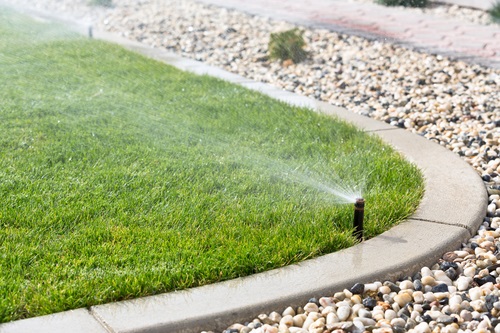
Irrigation Benefits Your Entire Property
You can even automate your system to behave differently in your garden versus your lawn, and you can also change up your watering cycles based on seasonal changes or plant growth.
Drip irrigation systems can also be extended to reach places that are just growing in or ones that didn’t exist when you originally installed the system. In terms of modifiability and adaptability to changing conditions, that’s pretty much the gold standard.
Especially when you’re dealing with a larger lawn in an arid region or a larger commercial property that needs virtually around-the-clock attention, an automated sprinkler system coupled perhaps with a drip irrigation setup can actually save you money long term. Homes benefit and conserving water, money and manpower is what it’s all about.
- Save Water, Conserve Manpower, Increase Curb Appeal
Drip irrigation is especially advantageous to homeowners and businesses in arid regions of the country that seasonally experience droughts, water shortages and steeper water prices (e.g., states like California).
The way that drip irrigation works – allowing water to drip down to different plants and root zones via pipes, emitters and valves – can consistently deliver more water to the roots and increase yields….all while saving water.
At the same time that you’re saving 50% more water compared to regular sprinkler systems, you’re getting better coverage and you’ll naturally experience less weed growth.
All of this together could very well bolster your curb appeal or, if you’re running a business, bring in more customers: A professional first impression goes a long way.
Incorporating Irrigation Into Your Lawn Care Routine
Business owners reading this might be scratching their chins and wondering whether they really need an irrigation system or if they can get by with simply watering twice a week. First off, you should realize that simply watering might not be enough.
If you’re running a commercial property, then irrigation is but one piece of the puzzle when it comes to maintaining a professional image. Mowing, mulching, fertilization, aeration and leaf removal might all be part of the overall picture in terms of getting the most out of your property or maximizing the curb appeal of your home.
That said, irrigation is one of those foundational lawn care services that really gets at the heart of landscaping. Why? Because irrigation delivers water right to the root source and if plants, trees and lawns don’t have enough water and sunlight they’ll definitely under-perform.
- Easy (and Expandable) Installation
While soaker hoses and sprinkler hoses might be the easiest-to-install and most DIY form of drip irrigation around, even professionally installed drip irrigation systems are relatively simple to install and shouldn’t require any excavation at all.
Because residential and commercial irrigation systems frequently rely on tubing, you can work with a landscape maintenance company to home in on the best location for the system. You can even move the system around if your needs change or power up/down the system to fit seasonal changes.
Drip irrigation systems efficiently deliver water right to the root source and are ideal for cost-efficiently achieving the best lawn possible. Consult with us on how you can benefit.
6 Xeriscape Ideas
Xeriscape gardens are specially built to require little to no irrigation. Instead, they’re specially constructed to use minimal water, and conserve the natural water (like rainwater) that enters their system. The end result is an environmentally-friendly garden that’s still beautiful.
Because xeriscape involves such skill and knowledge, it can be tricky to know where to get started. But with these six xeriscape ideas, you’ll get a head start on planning your garden.
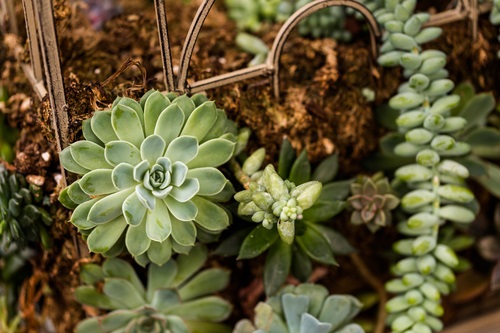
1. Think Beyond Cactus
Many people think xeriscape gardens are restricted to cactus and succulents. But most local plants are resistant to dry conditions in your area. Research native plants, or inquire with local gardening organizations, to find out what plants would flourish in your xeriscape garden.
2. Use Drip Irrigation
While many xeriscape gardens use no irrigation whatsoever, some use a form of irrigation called drip irrigation. Put small holes in a garden hose (or buy a hose specially perforated for this purpose), then lay it flat against the ground or near to it. Run this hose in the early morning or late evening, to minimize water loss due to heat.
The vast majority of the water through this slow drip system will get soaked up through the earth where it can nurture your plants, rather than getting lost to spray or evaporation. This is a good way to keep even drought-resistant plants through dangerous droughts, or to encourage your blooms to look their fullest during a dry season. To further maximize this method’s potential, place any plants that need more water close together, so they’re easier to water.
3. Try Perennials
Perennial flowers are more likely to be drought-resistant than annuals, and they’re lower maintenance, too. Try planting a group of perennial blooms close together to maximize their visual impact. For additional beauty, choose several perennials that will bloom at different times of year and plant them throughout your garden, to make sure you’ll always have something blooming.
4. Plan for Fall and Winter
Plants like Russian sage and many ornamental grasses dry out in the colder months. This is actually a positive: a well-planted standing will look like a dried bouquet. Add these to your xeriscape garden so there’s always something to draw the eye, no matter the season. You may even choose to avoid cutting back plants in colder months, to better take advantage of dried plants’ unusual shapes and appearances.
5. Fill Space with Rocks
Many xeriscape gardens gravitate toward gravel for open spaces. Gravel is great because it isn’t water-hungry like grass, and it holds moisture better than soil. But adding some beautiful rocks to cover space is a way to add texture and color to an area. Even just a small portion of rock garden adds character and variety to your xeriscape garden.
6. Play with Style
Not every xeriscape garden needs to look like a desert. With a little creativity and planning, xeriscape adapts well to any aesthetic or garden style. Don’t be afraid to think outside the box.
Xeriscape isn’t just environmentally friendly: it encourages creativity by imposing limits and forcing gardeners to think outside of comfortable tropes. Contact us and let us, plan and think creatively together. You’ll create a water-efficient space that’ll look its best in any season.
About Watering Lawn After Mowing
Engaging in watering lawn? As the weather heats up, more people will be venturing out into their yards to mow, plant, trim, and generally get things spruced up. Mowing the lawn becomes an almost constant chore from the time the dandelions pop up in the spring until the leaves fall in the autumn. Whether you choose to mow your own lawn or hire experienced professionals, you may have some questions about watering your lawn after mowing.
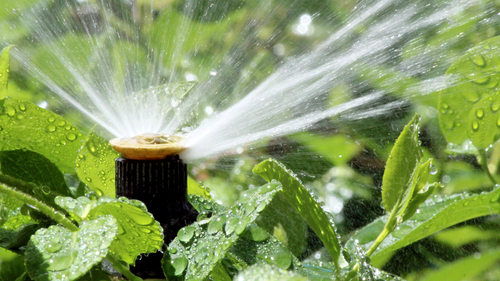
Setting a Schedule for Mowing
While mowing and watering are two separate chores which should both be scheduled, it’s important to leave room for flexibility for the days of drought and when it pours. The lawn needs mowing when the grass reaches a certain height and watering when the grass is dry. Those two events may or may not occur at the same time. Establishing a schedule to address these needs will help you make sure you aren’t wasting water or time. You should mow when grass reaches a height of about 3 to 4.5 inches. When it’s tall enough, trim it to about 2 to 3 inches. Depending on the season and type of grass, you may need to schedule mowing as often as every 5 days.
Setting a Schedule for Watering
Schedule your watering so that grass gets about 1.5 inches of water per week during the growing season. Time of day is also important to consider. Morning is an ideal time to water because it allows the grass to soak up the water before the heat of the day. Watering in the middle of the day wastes water because the sun speeds evaporation. In addition, watering too late in the day leaves insufficient time for the water to soak in before it cools off at night, potentially leading to fungal growth or other disease.
Knowing When to Water by the Color of Your Grass
Determining that grass needs water is a little tricky, but there are some things to look for. Grass that fades from bright green to a dull, bluish gray is probably thirsty. Also, look for signs of wilting, such as curling grass blades. Another trick is to look for footprints in the grass after you’ve been walking in the yard. Hydrated grass will spring back more than dried grass so, if you can see that you’ve left a trail, it’s time to water. One foolproof way to know if your grass needs a drink is to use a simple moisture meter, available at many garden stores. Or, utilize a rain gauge so that you know how much natural precipitation has fallen during the week.
A Pristine Lawn Takes Time and Attention
So, should you water after mowing? The simple answer is yes, but only if your grass needs the moisture. If you’ve had a rainy week and the grass isn’t showing footprints or other signs of dehydration, you can probably put off watering for a bit longer. If your lawn does need to be mowed and watered, make sure you schedule it for early in the day to avoid moisture evaporation and problems with disease. Don’t water your grass before mowing. Wet grass tends to clump together on the lawn which could suffocate the grass underneath or promote fungal growth. Also, it could clog up your mower.
Mowing is an essential aspect of home maintenance. A freshly-mowed lawn looks great, feels wonderful on bare feet, and helps keep invasive weeds in control. To handle all of your mowing needs, get in touch with the professionals at DK Landscaping today. You can trust us to keep your yard looking great for all seasons.
Narrow Walkway Flower Bed Ideas
Flower bed ideas can be quite easy to implement. Most gardens have walkways that are about two feet wide. Narrower walkways may help you to use a small space more efficiently.
However, they pose a unique design challenge to gardeners, landscapers and homeowners: how can you create and position flower beds so that they don’t visually overpower the walkways? Try these flower bed ideas to add variety and beauty to your space.

Perennial and Evergreen Flower Bed Ideas
Narrow walkways limit access to your flower beds, and make maneuvering through the space more difficult. Annual plants are flower bed ideas that can create headaches due to yearly replanting. By choosing perennials suitable to your climate, you’ll ensure that your plants come back each year and minimize the amount of work you (or your landscapers) must do.
You may also put evergreen plants on your list of flower bed ideas. These come back each year, and the plants won’t lose their leaves or fade in ways that require additional maintenance.
Keep Flower Beds Controlled
If your flower beds grow weedy or otherwise out of control, they can cut into your walkway. Normally that may be unsightly, but not a disaster. But if your garden’s walkways are narrow, this can make the pathway difficult to navigate, or even find. This is particularly problematic with gravel or dirt walkways, where the edges are already, often, poorly defined.
When going through your flower bed ideas, make sure that the line between the flower bed and the path is clearly marked. You may want a small fence, stone wall or other raised marker. Make sure your flowers are semi-regularly pruned back from the edges of the path, and that any weeds are removed. You may want to choose plants that grow more slowly, and that put off fewer vines or shoots for you to have to deal with.
Use Trellises
Trellises and fences are perfect flower bed ideas for climbing plants, that allow you more room to play. Be sure to choose climbing plants that don’t grow to too tall of a height, to minimize maintenance. Many vines are invasive, as well, so be sure that your final choice is native to your area.
Create a Unique Environment
Finally, once your flower beds are complete, your garden may feel crowded. Take advantage of this by creating a unique atmosphere. Delicate lighting along the edges of your path, or hanging from trees, can create a mysterious atmosphere like an enchanted forest. A little fence around the whole space, along with a gate, is one of those flower bed ideas that can make your garden feel like something out of a fairy tale.
Conclusion
When you want to implement your flower bed ideas, it’s time to call an expert. Contact us for a consultation about your yard and its specific needs, including repair, maintenance, irritation, and xeriscaping for saving water.
Layouts and Landscaping Small Backyards
They may be diminutive in size, but small backyards can be designed and landscaped in much the same way as their larger counterparts. From a quaint cottage-style yard to a modern, minimalist look, landscaping small backyards works best when you remember to design in square inches, not feet. In addition to this also use imaginative techniques such as creating multiple focal points, and use a varied selection of plants and shrubs. While backyards with limited space present a challenge, there’s nothing to prevent you from creating a cozy and charming retreat that can also work for family entertaining. To design a truly outstanding small backyard, follow these basic design and layout principles.
Inches, Not Feet
While most landscaping is planned out by the square foot, backyards with small footprints should be designed utilizing square inches, because fitting the amenities and plants you want in a tiny space requires a very precise layout. A mere two inches can make or break your opportunity to expand a raised planter wall to seat wall width; and just a six-inch difference here or there will determine whether you can have features such as ponds, fountains or fire pits.
Use Multiple Focal Points
Probably the biggest design challenge with small backyards is the lack of space to create that one standout focal point you often find in larger backyards. The solution, then, is to create many smaller, surprising focal points throughout your yard. Stone, ceramic, glass or metal accent pieces -new or vintage – can be arranged in such a way that they create an element of delight when discovered. For a distinct look, stay away from mass-produced items and make your small backyard uniquely yours by searching for one-of-a-kind pieces of garden art. For maximum effect, place your garden art amidst your plants, so they look as though they’ve always been there.
Don’t Stop at Green
Place bold and bright plants and flowers at the front of your small landscape so that they are the first thing to catch the eye upon entering the yard. They’ll also make the rest of the backyard recede, resulting in a larger feel to the space. Use plants with lots of texture, and try putting in a few large-leaf plants – they work wonders at changing the scale of small backyards.
Create Small Discrete Zones
As counterintuitive as it may sound, dividing a small space can actually make it seem larger. Try a tall hedge, fence, wall, or shrub to create a partition. Place furniture groupings and paths so that several small attractive and restful “rooms” are created.
Xeriscape Ideas for Small Backyards
Xeriscaping is one of the most popular landscaping options today, particularly in California, as it requires a minimal amount of water. In addition to reducing the need for supplemental irrigation, drought-tolerant landscaping can also be visually more interesting than other landscape options, and it will save you money. Xeriscape landscapes require very little turf, include plants that can withstand harsh elements and embrace designs that make small backyard landscapes really stand out:
- Use stepping stones and gravel to create a path and then fill in the side areas with native grasses.
- If you have stairs up to a deck or patio, fill them with gravel and native plants to add an unexpected touch.
- Choose low maintenance greenery that will thrive in your zone and don’t forget to opt for some colorful choices – the results can be stunning.
Bringing big design to small backyards is a great way to create a space for family and friends to dine and play. So contact us for consultation. Don’t be surprised if it becomes everyone’s favorite place to gather!
Building a Rock Garden: Everything You Wanted To Know
Rocks gardens, sometimes called alpine gardens and less commonly rockeries, are structures made from stones, rocks and boulders that you can build around your garden populated with perennials and annuals to really set it off.
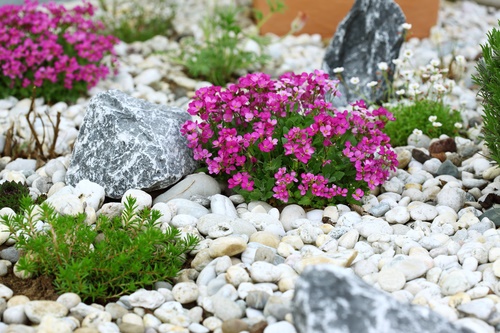
Rock Garden: What You Should Know
Usually rock gardens are role players or a kind of supporting cast for the main players that are your perennials, biennials and annuals.
The exception would be some Zen gardens in Japan that are designed almost exclusively from rocks, boulders and sand and designed to open the doors to enlightenment…but for now we’ll keep both feet squarely planted in the real world.
- Why Create a Rock Garden?
A lot of homeowners want to know right off the bat why they should be investing their time and energy into a rock garden in the first place.
That’s a great question and the answer really boils down to aesthetics and practicality. On the aesthetics point, rock gardens can lend a rugged air to your garden and make a very natural complement to your roses and annual flowers.
The other side of the coin is practicality: Rock gardens make a lot of sense if you’re working with an area that hards to reach with a lawnmower and provide regular maintenance to.
Many homeowners also consider putting up a rock garden to make a clearer demarcation line between an outdoor patio area, mulch and their garden proper. This really lends a lot of perspective by creating a more dynamic environment and allowing you to naturally get a wider color palette into your backyard.
- Where to Plant Rock Gardens?
You definitely want to select the right rocks and stones for the job when it comes to creating a rock garden that naturally allows you to find the optimal balance between earth tones and flowering brilliance.
For instance, if you have a lot of outdoor space in your backyard and a slight undulating up (or down) that might call for a staircase comprised of stone slabs or a tiny pebble walkway, then you could try something like this to lend more perspective and work with the existing elements.
You can even light the way with sconces along your pathway and combine stone slabs with more petite rocks forming your walking path. A few low maintenance yet vibrant perennials like dahlias and creeping thyme can work great running along the side too.
If you’re dealing with a really steep slope, then working in some larger rocks or complementing preexisting boulders can make a great retaining wall or framing device for a rock garden down below. A combination of flowers, shrubs and chips can set things off underneath.
You might also try erecting a rock garden near hard-to-reach areas running along a fence or hilly areas as these really are the perfect excuse for building up a rock garden and turning lemons into lemonade with your next outdoor project.
- Can I Still Go Zen?
You absolutely can still incorporate aspects of a traditional rock garden into your next backyard project!
The Zen Temple of Ryoanji means The Temple of the Dragon at Peace, and it’s easy to see how it got that name: Using open space to its advantage, Zen rock gardens are peaceful reposes and typically only call on a few rocks, pebbles and moss to achieve their tranquilizing effects.
To create your own Zen rock garden use edging stones, pebbles and prune your plants to fit the aesthetic you’re going for. For help getting there, contact us the gardening professionals.
Gardening Advice from a Landscape Maintenance Company
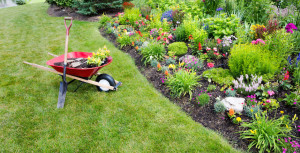 Most people expect three things from their landscape: for it to look good, for it to require little maintenance, and for that maintenance to be inexpensive.The reality is that to keep your garden looking green and healthy, you will have to invest a lot of time, money and effort. Serious gardening may not be easy if you have a busy life. However, with a little planning and the right advice, it is possible to reduce gardening costs while still having an aesthetically pleasing garden. In order to get the most out of your gardening time on the weekends, consider the following tips:
Most people expect three things from their landscape: for it to look good, for it to require little maintenance, and for that maintenance to be inexpensive.The reality is that to keep your garden looking green and healthy, you will have to invest a lot of time, money and effort. Serious gardening may not be easy if you have a busy life. However, with a little planning and the right advice, it is possible to reduce gardening costs while still having an aesthetically pleasing garden. In order to get the most out of your gardening time on the weekends, consider the following tips:
- Understand Your Garden
Before you decide to add anything new to your garden or to make any big changes, look at what is already there. Pay attention to the weather, as well as to the light and soil in your yard. Look at the types of plants that are thriving under the conditions present on your property. When you go shopping for new plants, look for ones that flourish under those same conditions. - Put in a Few Trees
Trees are an excellent addition to your property and can help to increase its value. Mature trees not only provide a degree of privacy for your home, they can provide protection for plants lower to the ground as well. Trees last for a long time and require relatively little maintenance. - Choose the Right Plants
If you are a busy person without much time for gardening, you may want to focus on low maintenance plants. It is important to remember that the meaning of a term like “low maintenance” can differ from person to person. Plants that are considered by others to need little maintenance may actually require more gardening time than you are able to invest. If you have limited time for gardening, consider hiring a professional to handle your landscape maintenance. With their help, you may be able to get plants that require more effort. - Take Out the Tough Weeds Prior to Planting
When you are putting in a new landscape, preparation makes all the difference. By carefully preparing the soil, you can substantially reduce the amount of time and effort that you spend gardening. Remove the top layer of sod in the location that you intend to use for your garden. Completely remove annual and perennial weeds from the area as well. Till the soil and let the sun dry out any remaining weeds. Give it a week before tilling again. - Choose Plants of the Right Size
Look at the tags on your plants to find out how large they will get. Avoid crowding your garden beds and pay attention to the plants’ growth tendencies rather than try to restrict them. - Pruning
Good gardening involves pruning your plants annually to maintain their health and to keep your garden looking neat.


